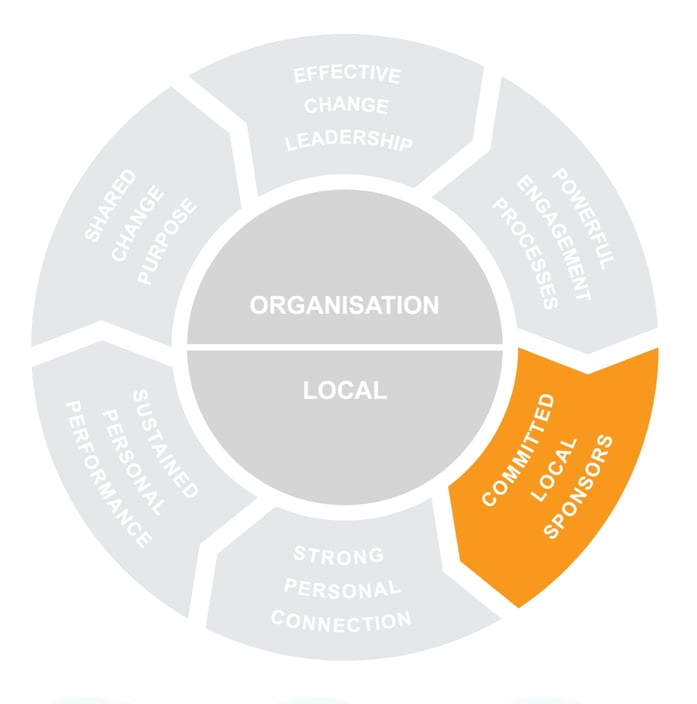
Driving successful change means balancing the local and organizational factors. Committed local sponsors can help you drive through local change while you are focusing on aligning and cascading the organizational elements of change. Effective change leadership at the local level is critical for ensuring consistent change throughout the organization. Over the next three weeks we will be looking in more detail at the local change factors.
Local leaders are critical for successful, fast-paced change
Last week we touched on the fact that successful change implementation is about matching what the company needs with what the people in the organization can accomplish. In a time of constant change, as companies are continually evolving to meet market needs and competitive forces, we ask a lot from the people in the organization. Creating leaders and teams that have the skills to adapt to fast-paced change is key for driving through successful change, time after time.
During July and August we are discussing the 6 critical success factors for change. Three success factors sit at the organizational level; three factors sit at the local level. This week we will look at CSF4, and provide insights on how to create a network of committed local sponsors.

Critical Success Factor 4: Committed Local Sponsors
Local managers are in a unique place to drive through the change agenda. For example, they can help people see how the change is relevant to them, they can role model the change so that people can see what is expected of them and they can provide a ‘buffer’ that can give people time to adjust. On top of that, they are often the most trusted by their people and so can be used as a sounding board to air concerns. They can help create a positive climate for change.
Building effective local sponsors
With all of this in mind, you want to be enabling local sponsors to be as effective as possible at change leadership. Remember, that the skills for effective change leadership can be learned. Given the right approach and framework, you can create a powerful network of local change sponsors:
- Create a sponsor map at the local level: Similar to the work you did at the organizational level, create a sponsorship network map to identify who are the leaders that will have accountability for change in the affected parts of the organization. Don’t forget to map in the influencers as well, your local leaders may be able to help you identify who the key influencers are that need engaging in their areas. A helpful technique to use is the Changefirst Change Network Mapping.
- Work with organizational sponsors to build their local commitment: while local sponsors have the power to drive through your change, they also have the power to block the change from happening. Remember that local sponsors are people who need to be engaged and to build their own commitment first before you expect them to help others to commit and adapt.
- Clearly set expectations for your local leaders: define up front the role you expect local leaders to play during change. It may be that your local sponsors have never had the responsibility to lead change before, or that they have been involved in poorly managed change. Either way, ensure you have clearly defined the role you need local leaders to play. Local sponsors should be:
- actively involved and provide hands-on leadership
- communicating, via their actions, their total commitment to driving the
project forward - accountable for the complete and timely implementation of the
change in their area.
- Give local sponsors the change skills to be effective: Identify and fill skills gaps in your local sponsor network. This can be through formal training, as well as mentoring and coaching from the executive sponsors and change agents. Key skills, tools and techniques that your local sponsors need include:
- How to lead change
- How to help people adapt to change, and manage individual and team reactions to change
- How to manage their own reactions to change during the full change lifecycle and increase their resilience to change.
- Provide concrete opportunities for role modelling: Local sponsors should be leading change through role modelling the change and providing hands-on support for their people. To do this, they need early opportunities to actively role model the new requirements, such as: values, behaviors, system or process changes. Expose your local sponsors to the changes early, allow them to become confident in the new way of doing things as the precursor to full implementation.
The job of the local sponsor is to work out how to get people to commit to the change and to change their behaviors. Effective change leadership is created by identifying the local managers who have the accountability and responsibility to drive change through their areas of the organization, engage with them upfront and provide the skills and support to lead the change in their teams.
Learn how building committed local sponsors integrates with the other 5 critical success factors in our whitepaper on our change management methodology. And you can find out more about effective leadership at the local level, and to read some real-life examples of the trials and errors of building local sponsorship, in chapter 8 of our book, Successful Change.


Leave a comment